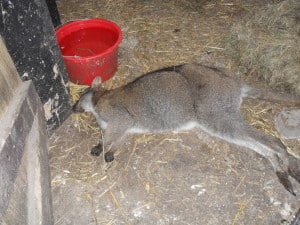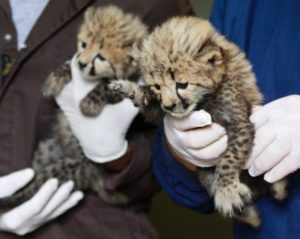This year thousands of locals and tourists will flock to Zoo Atlanta in hopes of seeing animals one can only see in the wild, or on T.V. A trip to the zoo is supposed to be about fun, entertainment, as well as a learning experience. Zoo animals are big, exotic, and beautiful; however, they are not in their native environments. Pushed behind durable glass enclosures, enclosed behind fences, and oftentimes lonely, many animal activists argue that animals at the zoo are indeed unhappy and suffering.
For this reason, I believe there should be tougher laws governing whether or not an animal should end up at the zoo if there is no significant reason for it to leave its natural habitat. Animals in the wild should be left in the wild so that they are able to survive, as well as mate successfully on their own. Taking animals out of the wild for display only takes away their primal instincts, thus making them susceptible to any dangers of the wild if ever released.

On any given day, thousands of people worldwide will pass hundreds of animal exhibits, many of these people won’t stand at the animal’s exhibit long enough to take notice that something is wrong with the animals’ living conditions. The sad reality is most zoo-goers probably could care less about the animals they are looking at.
The small enclosures should be enough to make one stop and ask why, but no one ever does. In an article by The Global Post entitled World’s worst Zoo, the author Jackie Leavitt gives readers their first glimpse into the horrible enclosures in which animals live. Leavitt states that the animals often lived in concrete and iron dwellings, and cages too small for the animals to live in (Leavitt 2010).
Another article entitled Six of the saddest zoos in the world by animal zone stated that animals at an Albanian zoo were kept in small, barren, featureless rooms lined with hospital-like floors, and the bears at the zoo were often kept in chain-linked fences, yes chained linked(animal zone,2013)! Along with these horrible dwellings the animals did not have adequate food or water. Why isn’t something being done faster? The plight of these helpless animals in these enclosures is dangerous and inhumane. What could be worst than the enclosures themselves, the environment?
Human beings should consider the conditions in which the animals live instead of only being concerned about human entertainment. In a recent study by Andrew Balmford, a professor from Cambridge University stated that zoo-goers were not learning anything about the zoo animals, nor their habitats or conservation( Dinfielder, and Balmford 2007). The question I have asked many of my friends is which is better, seeing animals in the wild or in a controlled environment?
All of my friends replied to the zoo; they simply feel they will never have the opportunity to travel. Although seeing animals in the zoo will cost individuals less than one hundred dollars compared to seeing them thousands of miles away, this is a convenience for many zoo-goers but at the expense of animals in rotten living enclosures and environments. When animals are at the zoo they are subjected to abnormal and or dangerous situations, such as fake shrubbery, artificial rocks, and zoo psychosis a condition in which animals are under extreme stress as well as depression.
In a 2006 study by the National Science Foundation, Falk and his colleagues stated that zoos prompt individuals to reconsider their roles in environmental problems and conservation actions. Falk also stated that individuals saw themselves as part of the solution( Falk,2006). If indeed this were true, wouldn’t it make more sense to keep the animals’ natural habitat safe? Human beings destroy the natural habitat by landscaping, soil erosion, building dams and roads, polluting the water, and most of all human overpopulation(Bowden,2002).
On the flip side, there are those who look at zoos from a brighter picture, believing that zoos are very beneficial to the animals there as well as human beings. Conservationists believe that zoos help save thousands of endangered animals, yet conservationists aren’t always right.
It is fair to say that no animal should be pushed behind a heavy glass, or roaming like a chicken with its head cut off in a tiny enclosed fence. The many animals at the zoo are often alone and separated from other animals. A prime example of this is the anxiety baby monkeys feel when they are separated from their mothers.
The monkeys became stressed and could not function properly(Mail Online,2011). Another prime example is the fact that elephants travel miles and miles in herds with their offspring and other relatives for food or water, this cannot be achieved due to separation in zoos(Vegan peace n.d). The animals we see in the tiny designated areas are there every day, every year, and every week.
Appearing well trained, zoo animals have given up the fight to hold onto any shred of their former selves. As with any argument, there is a positive. The positive part about zoos and animal bonding is the small sectors of zoos that offer wildlife safari parks. The San Diego wildlife safari and the Henry Doorly Zoo located in Omaha Nebraska, are just a few. These parks allow the animals to roam freely.
Zoo animals through all their suffering eventually lose their primal instincts and succumb to various diseases within their zoo environments. Hunting in packs or herds was once a norm for many of the animals found at the zoo; however, when the food is already prepared there is no need for groups or hunting.
Many diseases that plague zoo animals include various forms of the herpes virus, E.coli, Hepatitis B, Shigella, and Tuberculosis, all passable to human beings(Ball, n.d). On a positive note, with help from veterinarians, these diseases can be cured, which will aid in the animals living a longer life. Aside from lack of hunting and diseases, zoo animals have been put into situations where they have to mate assisted.

For instance, cheetahs at the Smithsonian National Zoo in Washington State go through an extensive breeding program, despite the fact that the cheetah species are not easy to mate in captivity.
The program itself cost $350,000 a yr., yet the program is not really a success, only fifteen cubs are born to the two hundred and eighty-one cheetahs in captivity here in America each yr.(Kaufman,2012). The Audubon Institute is also concerned with the preservation of wildlife species and helping in the mating process. The institute freezes biological material from animals such as gametes, embryos, tissue samples, and serums.
Freezing the biological material does serve important factors as well, keeping animals from extinction and holding onto irreplaceable genetics(Audobon Research Institute,2013). With both good and bad points facing zoos, there are still many factors to consider when taking aside.
Lastly, there should be more laws governing the treatment of zoo animals. These laws should decide if the animal should stay in the wild, and when the animal can be released in the U.S. The laws should also make sure animals are given the proper environment to dwell in such as mimicking the wild with real bushes and rocks and sunlight, providing the animal with what it would need to actually survive in its natural environment.
The laws should also hold more people responsible for taking the animals out of the wild for profit, or for no significant reason. If people are taking the animals for conservation, then we as humans should start with their natural environments first. Advocates worldwide are advocating for tougher laws and bringing into focus the reality of captured wildlife.
Thousands of animals, reptiles, and birds will find themselves far away from home, as man continues to bring them into zoos. Boxed up and shipped away, many of these animals will be afraid, and alone. There is a sense of urgency that something needs to change, fast. Human beings have the power to change the conditions facing zoo animals. In doing this, there will be fewer animals at the zoo. Cages and glass enclosures are not homes for animals; we as human beings owe it to all zoo animals to keep them in the wild and free- as nature intended.
References
Animal Zone(n.d,n.p) Six of the saddest Zoos. Retrieved from http://www.animals-zone.com/saddest-
Zoos-world
Audobon Research Institute(2013). Frozen Zoo. Retrieved from http://www.auduboninstitute.org/frozen-zoo
Ball,J(n.d,n.p). Zoonotic Disease. Retrieved from
http://www.johnballzoosociety.org/AZAVA/admin/zoonosis-RHWA.pdf
Bowden,R.(2002) An Overcrowded World? Our Impact on the planet. Austin TX: Raintree-Steck-Vaughn
Publishers Retrieved from http://library.thinkquest.org/08aug/00473/overpopulationhumans.html
Dinfielder,S.and Balmford. A,(2007) Wild encounters volume 40.No 10,Print version page 32 .American
Psychological Association. Cambridge University Press. Retrieved from
http://www.apa.org/monitor/2009/11/conservation.aspx
Falk,J.H(2006). Why Zoos and Aquariums Matter: Assessing the Impact of a visit to a zoo or aquarium.
Retrieved from http://www.aza.org/uploadFiles/Education/why zoos matter.pdf
Kaufman,L.(4 July 2012). Date night at the zoo if rare species play along. The New York Times Retrieved
from http://www.nytimes.com/2012/07/05/science/matchmaking-at-zoos-is-rising-for
threatened-species.html?pagewanted=all
Leavitt,J.(7 October 2010). The world’s worst Zoo. The Global Post. Retrieved from
http://www.globalpost.com/dispatch/global 1100629/worst-world-zoos
Mail Online ( 2011 August 18). Monkeys separated from mothers suffering stress, depression, and poor
social skills Retrieved from http://www.Daily mail.co.uk/sciencetech/article-2027485/Monkey –
seperated-from-mother-suffering-stress-depression-poor-social skills.html
Vegan peace (n.d). Zoos. Zoo Issue/Milwaukee County Zoo Retrieved from
http://www.veganpeace.com/animal cruelty/zoos.html

Very inspiring
I AGREE
Indeed